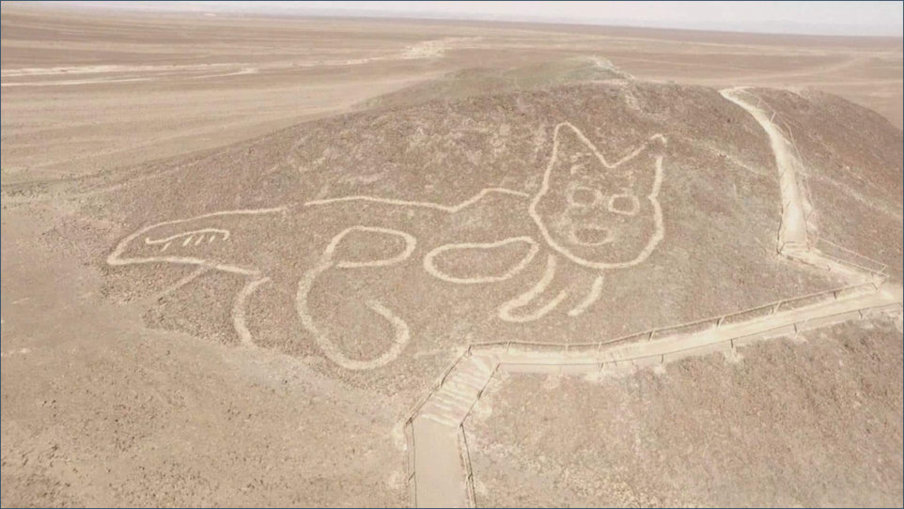Nazca Cat
Return to Home Page or Cat Home Page
2020 - The Nazca Cat is discovered
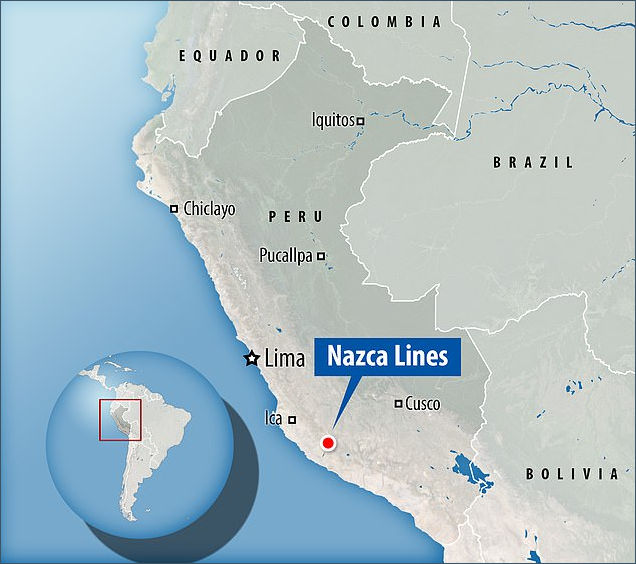
'Nazca lines were not completely understood until invention of airplanes because they cannot be fully realized from any point on land and drones have helped understand them further' - image and strapline courtesy of the Daily Mail
WHAT ARE PERU'S MYSTERIOUS 'NAZCA LINES'?
Geoglyphs span large land tracts located between the towns of Palpa and Nazca. Some geoglyphs depict animals, objects or compact shapes; others are only simplistic lines. The Nazca people lived in the area from 200 to 700 CE. Some of the designs are believed to be created instead by the Topará and Paracas people. Most of the lines are formed by a shallow trench with a depth of between four inches (10cm) and six inches (15cm), made by removing the reddish-brown iron oxide-coated pebbles that cover the surface of the Nazca desert and exposing the light-colored earth beneath. This sublayer contains high amounts of lime which has hardened to form a protective layer that shields the lines from winds and prevents erosion. Paul Kosok, from Long Island University, is credited as the first scholar to seriously study the Nazca Lines. He discovered that the lines converged at the winter solstice in the Southern Hemisphere.
Along with Maria Reiche, a German mathematician and archaeologist, Kosok proposed the figures were markers on the horizon to show where the sun and other celestial bodies rose. Source: UNESCO
Full view of the Nazca Cat - image sourced from & © of cbc.ca with thanks
Large 2,000-year-old cat discovered in Peru's Nazca lines
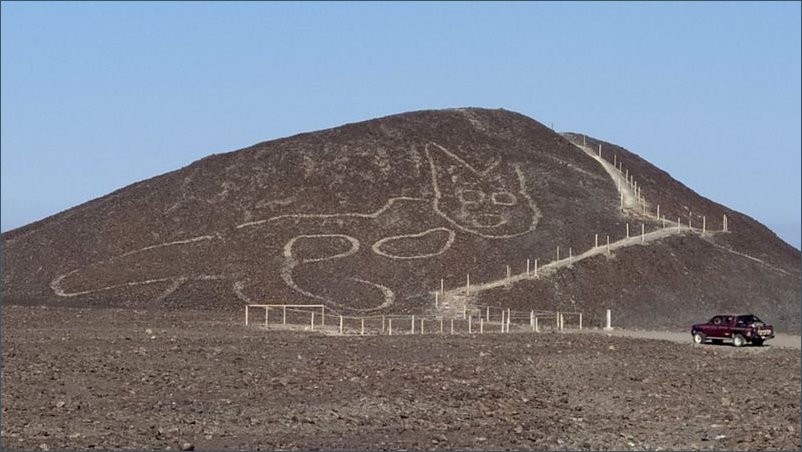
It is estimated that the cat image is about 37m long - image sourced from the BBC News website with thanks - image © EPA
The figure of a relaxing cat has been discovered in the Nazca desert in Peru. The Nazca lines, a Unesco World Heritage site, is home to designs on the ground - known as geoglyphs - created some 2,000 years ago. Scientists believe the cat, as with other Nazca animal figures, was created by making depressions in the desert floor, leaving coloured earth exposed. The cat then went unnoticed until plans were recently drawn up for a new path leading to an observation platform. The platform would have provided a vantage point for visitors to see many of the other geoglyphs.
In a statement, Peru's culture ministry said: "The figure was scarcely visible and was about to disappear, because it's situated on quite a steep slope that's prone to the effects of natural erosion." It added that the geoglyph, which is about 37m (120ft) long, has been cleaned and conserved over the past week. Johny Isla, Peru's chief archaeologist for the Nazca lines, told Efe news agency that the cat pre-dates the Nazca culture - which created most of the figures from 200 to 700 AD. The cat, he said, was actually from the late Paracas era, which was from 500 BC to 200 AD. "We know that from comparing iconographies," he said. "Paracas textiles, for example, show birds, cats and people that are easily comparable to these geoglyphs."
The ancient cat that was hidden for 2,200 years: Geoglyph is uncovered etched into a hillside at site in Peru that was home to mysterious desert-dwelling civilization
- Researchers have discovered new geoglyph etched into hillside in southern Peru
- The Nazca lines design appears to depict a giant cat and measures 120 feet long
- Archaeologists made discovery while work was carried out on public view point
By Natalia Penza and Katie Feehan for Mailonline | Published: 18th October 2020 | Updated: 18th October 2020
An ancient design depicting a huge cat has been discovered etched into a hillside in Peru's Nazca Desert. The new Nazca Lines etching, known as a geoglyph and showing a120-foot long feline, lay undiscovered for nearly 2,000 years on a hill beside the Pan-American Highway stretching from Alaska to Argentina. The Nazca Lines in southern Peru are a group of geoglyphs etched into desert sands and there are about 300 different figures, including animals and plants. Archeologist Jhonny Isla said the latest design had been found during work to improve access to a visitor look-out point which enables people to view the giant figures that make up the mysterious Nazca Lines. Mr Isla, in charge of the management system for the Nazca-Palpa Archeological Park, said: 'We realised the access to the look-out point ran over a geoglyph and we decided to alter it because it's not possible to promote access by damaging heritage. 'The additional motive was that access was complicated and we wanted to make it safer. 'During that process, we realised there were lines that were definitely not natural.' He added: 'It might seem surprising that new designs are still being found, but we know there are more out there. 'In the last few years the use of drones, which enable us to take images of the sides of hills, makes that possible.' Peru's Culture Ministry said in a statement: 'The design was hardly visible when it was first identified and was on the verge of disappearing because it was on a hill with a steep slope and was subject to the effects of natural erosion. 'Over the past week cleaning and conservation work has taken place which has led to the emergence of the figure of a feline with its body side-on and its head facing forwards. 'The lines of the geoglyph are around 12 to 15 inches wide in some parts. The figure is 121 feet long.' Officials dated the design to around 200BC.
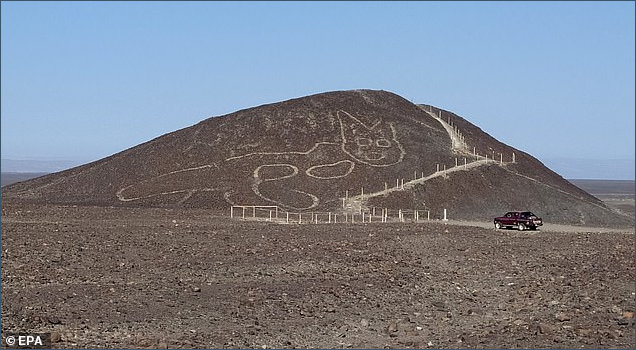
The figure of a giant cat has been discovered by archaeologists etched into the hillside of the Nazca Desert in Peru where hundreds of other Nazca Lines geoglyphs can be found in the sand - strapline & image sourced from the Daily Mail and © of EPA
Mr Isla said the cat dated back to the late Paracas era, which ran from 500BC to AD200. He added: 'We know that from comparing iconographies. Paracas textiles, for example, show birds, cats and people that are easily comparable to these geoglyphs.' Last November it emerged over 140 Nazca lines dating back around 2,100 years had been uncovered in the Peruvian desert. The announcement was made by archaeologists at Japan's Yamagata University following a 15-year research effort using satellite imagery, drone footage and AI scanning systems. They included a bird, humanoids, a two-headed snake and even a 'killer whale'. The Nazca Lines, a UNESCO World Heritage site, were first 'discovered' by archaeologists academically in 1927. Many are so big they can generally only be identified properly from the air. It is believed they were created between 500BC and 500AD. They typically measure anywhere from 0.2 miles to 0.7 miles across. Many depict humans, animals and plants. Experts believe the lines, thought to have been made by the removal of rocky black topsoil to reveal light-coloured sand underneath, were used in ritual ceremonies and may have served as messages to the gods.
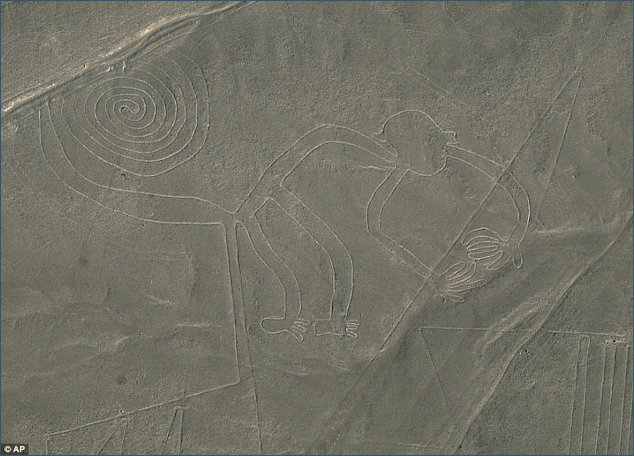
'An aerial view of a spiral-tailed monkey figure in Peru's mysterious Nazca Lines, located some 240 miles south of Lima. No one knows why the Pre-Inca Nazca culture made the figures and lines, some of them miles long' - strapline & image sourced from the Daily Mail with thanks, image © AP
In February 2018 a lorry driver was arrested after ploughing through the ancient lines and leaving 'irreparable tyre scars'. He claimed at the time his vehicle had suffered a mechanical problem and he pulled over to change a tyre.
The Smithsonian Magazine
2,000-Year-Old Nazca Line Featuring Lounging Cat Found in Peru
The enormous glyph is one of hundreds of ancient etchings scattered across the arid region
By Isis Davis-Marks | smithsonianmag.com| 19th October, 2020
Archaeologists have discovered a 2,000-year-old etching of a cat carved into a hillside some 250 miles southeast of Lima, Peru, reports Spanish news agency EFE. The feline, which measures about 120 feet long, has wide, orb-like eyes and appears to be sunning itself. The newly identified likeness is a Nazca Line - one of hundreds of ancient drawings created in the Peruvian desert by removing rock and soil to produce a "negative" image in the sand, writes Jason Golomb for National Geographic. Other Nazca Lines depict animals including orcas, monkeys, hummingbirds and spiders, as well as geometric shapes and humanoid figures. Dated to between 200 and 100 B.C., the geoglyph is thought to be older than any others previously discovered in the region. Workers identified the etching while remodeling a portion of the Nazca Lines Unesco World Heritage Site, reports Tiffany May for the New York Times.

'[It] was about to disappear because it’s situated on quite a steep slope that’s prone to the effects of natural erosion' Peru's Ministry of Culture explains. - Image (uncredited) as it appears in the Smithsonian Magazine
"The discovery shows, once again, the rich and varied cultural legacy of this site," says Peru's Ministry of Culture in a statement. Per the statement, the image of the lounging cat was "barely visible" prior to cleaning and conservation. As the Times notes, researchers only found it after spotting signs of "something intriguing" near the Mirador Natural lookout point. "[It] was about to disappear because it's situated on quite a steep slope that's prone to the effects of natural erosion," the ministry explains. Famed for their impressive scale and complexity, the Nazca Lines have fascinated researchers since their modern rediscovery in the 20th century. But experts remain divided over why the Nazca civilization, which flourished in southern Peru between 200 B.C. and 600 A.D., dedicated so much time and energy to creating the massive figures. Peruvian archaeologist Toribio Mejia Xesspe was the first to systematically study the lines, examining them from the ground in 1926. The following decade, commercial pilots provided a fuller aerial view of the glyphs; between the 1940s and '70s, Nazca experts Paul Kosok and Maria Reiche argued that the lines fulfilled "astronomical and calendrical purposes," per National Geographic.
More recent investigations have shifted away from Kosok and Reiche's theories, instead positing that the lines relate to religious rituals designed to encourage rainfall and fertility. Increasingly, wrote Stephen S. Hall for National Geographic in 2010, researchers are starting to agree that "[t]hey were not made at one time, in one place, for one purpose." Last year, archaeologists from Japan's Yamagata University drew on satellite imagery, fieldwork and artificial intelligence analysis to identify 143 new Nazca Lines. According to a statement, the findings suggested that larger glyphs served as ritual sites, while smaller ones acted as location markers for travelers. "It's quite striking that we're still finding new figures, but we also know that there are more to be found," Johny Isla, Peru's chief archaeologist for the Nazca Lines, tells EFE. The Peruvian desert's arid climate has preserved the Nazca Lines for millennia. But erosion and human activity pose significant threats to the glyphs' survival. A single footprint or tire mark could permanently destroy the surface of these ancient lines - and, in recent years, such damage has become increasingly common. In 2014, Greenpeace activists smudged the surface of a Nazca Line during a demonstration calling for action on climate change, and in 2018, a truck driver was arrested after he intentionally drove a tractor across a condor-shaped glyph.
Back to Top / Return to Cat Home Page / Home Page
Page created : 22nd October 2020 (G)
